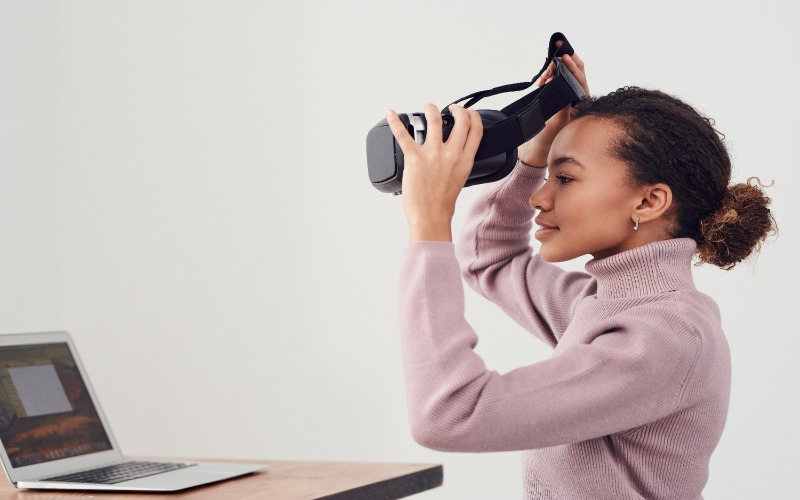Augmented reality (AR) glasses rely on the use of digital imagery and animations to enhance the wearer’s environment by blending artificial elements with the real world. While AR is commonly used by consumers on their mobile devices, AR glasses are being widely used in corporate settings as a training tool and have improved efficiently across several different industries.
What Exactly Are Augmented Glasses?
Far from a passing fad or a simple flight of fancy, augmented reality (AR) glasses are showing a good deal of promise in today’s tech space. Consumers who are using AR applications on their tablets and smartphones make up a smaller demographic when compared to the larger adoption rates seen by businesses that primarily use AR for instructional tools and employee training.
Augmented reality merges real world environments with digital enhancements that make artificially created images and animations appear indistinguishable from our actual world.
Average consumers commonly use augmented reality technologies on their mobile devices through face filter applications and instances where they can select their physical attributes to create gaming characters representing them in the digital world.
Some experts believe that while AR in smartphones and tablets may currently be perceived as a novelty, it is in fact stoking public interest and preparing us for the advances that have yet to come.
Perhaps one of the world’s biggest proponents of AR is Tom Emrich, who started working in the AR space in 2009 and has provided strategic direction in emerging technologies for several brands and organizations over the years he’s been active in the industry.
As one of the founding partners of Super Ventures, a Silicon Valley-based venture capitalist fund, Emrich has been investing in AR’s early development and is convinced that wearable technology backed by AR is the future.
“These next few years we will see a boom in smartphone AR thanks to developer platforms from the likes of Google, Facebook, and Apple,” Emrich said in a statement.
He added, “These experiences will act as ‘AR training wheels’ for enterprises, developers, and consumers alike, preparing us for the need for a new head-worn form factor while buying the time for the head-worn technologies to become smarter, smaller, more cost-effective and ready for widescale adoption.”
That “boom in smartphone AR” has yet to be fully realized, which is the case when major technological advancements are still in their early stages of development.
Useful in Many Professions
However, AR glasses are already being used in the corporate world and are improving workplace processes by giving employees the opportunity to receive real-time instructions and enhance their training remotely through the use of this wearable technology.
Augmented reality glasses commonly utilize cameras and certain sensors like lidar to analyze the wearer’s environment. Through artificial intelligence (AI) and machine learning, the construction of a virtual map based on the wearer’s surroundings is created thanks in large part to the various sensors being used. Inserting a digital object on a virtual map using AR glasses makes that digital object appear in the wearer’s physical environment.
AR glasses have demonstrably altered how many business sectors perform their duties in a way that increases efficiency and leads to fewer accounts of human error. For example, we’re currently seeing this technology being used for remote assistance and real-time collaboration in certain industries.
Field workers use AR glasses for instant communication with experts that can coach them to quickly solve issues remotely and securely. On-site workers receive AR-enabled digital work instructions in their AR glasses where digitized animations and images are viewed in the worker’s physical environment.
This technology is also being utilized in the healthcare industry, particularly as a surgery aid. AR glasses are altering how surgeons perform their duties and are changing the face of healthcare as we know it.
Surgeons can rely on AR to execute real-time surgeries without the presence of personnel who would ordinarily assist during surgical procedures. Through this wearable technology, surgeons can use their speech and eyes to receive prompts and commands directly through their AR glasses.
Additionally, auditors can conduct their inspections with greater proficiency. By using visual interactive checklists via their AR glasses, these auditors help eliminate errors in their work, while boosting productivity and reducing overall cost.

Are They Ready for the Consumer Market?
Despite the fact that augmented reality glasses have been more commonly used by working professionals, the idea of widespread adoption is stoking the desires of some consumers who want the biggest and latest in technology.
In 2017, business magnate and Facebook co-founder, Mark Zuckerberg, told Vox Media that the tools Facebook had at its disposal to create AR glasses that met the standards of his business were still “primitive.”
“I think everyone would basically agree that we do not have the science or technology today to build the AR glasses that we want,” Zuckerberg told Vox. “We may in five years or seven years, or something like that. But we’re not likely to be able to deliver the experience that we want right now.”
Roughly six years later, Facebook’s consumer-focused AR glasses have yet to come to pass, though Zuckerberg and company have made strides in delivering VR technology where users can create digital representations of themselves to connect virtually with one another in the metaverse. However, there is a substantial difference between AR and VR and the former is an area that still needs further development before it is ready to be unveiled to the masses.
When Will AR Glasses Become Widely Used?
A decade ago, Google made waves when it released its ill-fated Google Glass, which was a pair of AR glasses that was timed for a market that wasn’t ready to accept them—with certain experts citing technological limitations and issues over privacy.
As of July 2022, Google announced a revision to their original design and according to the 1.29 trillion dollar company, their new AR glasses prototype will be tested in public settings and will utilize microphones, cameras as well as a transparent display. How the new prototype will perform in real-world scenarios has yet to be seen.
Overall, the future of AR glasses is rife with benefits, as the technology continues to evolve. Wearables that work seamlessly with augmented reality present a significant technological and societal breakthrough and can influence a direct shift towards mainstream adoption, though we’ll have to wait with bated breath before that future becomes a reality.










